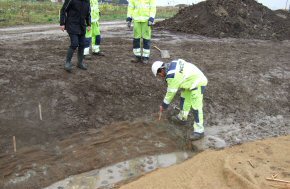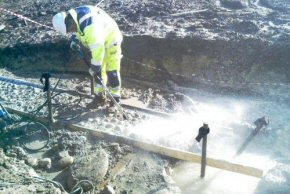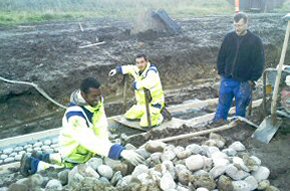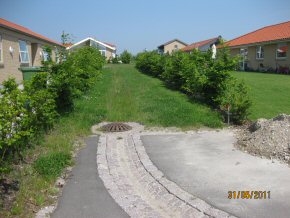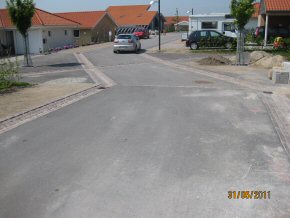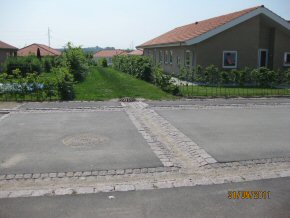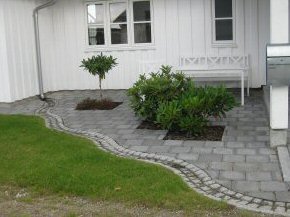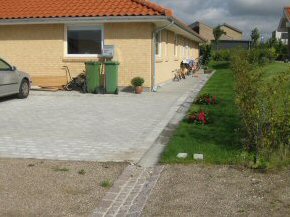Trekroner. Visible diversion of rainwater
Trekroner Øst – New urban district, surface drainage of rainwater
In the new Trekroner Øst urban district, in which 1,000 homes are being built in Trekroner, Roskilde, runoff rain is handled visibly in the local landscape. The area is already characterised by small lakes, the Langebjerg lakes and Himmelev Brook, which runs into Roskilde Fjord. A watershed runs down through Trekroner Øst such that the eastern urban district drains into the Langebjerg lakes and the western urban district drains to Himmelev Brook. Rainwater is diverted from roof surfaces, green areas and roads in open trenches and swale-trench systems throughout the entire catchment. The open rainwater system is made up of several different types of trench systems and swale-trench systems.
Rainwater runoff from the eastern part of Trekroner Øst is directed through an open green rainwater basin before the outlet to the Langebjerg lakes. Drainage from the basin is controlled by a water brake in order to regulate the hydraulic load of the lakes. In continuation of the outlet from the water brake, a infiltration system with infiltration through a layer of sand is established along the lakeshore. The basin is established as a green basin with a "filter system" in order to reduce the nutrient load on the Langebjerg lakes, which are phosphorus-loaded. The purpose of the filter is to retain and convert nutrients, and the grass and rushes in the basin are cut back once a year. The discarded plants are removed from the area in order to remove nutrient salts.
In addition to the circulation/retention of nutrients that takes place in the rainwater basin, the open rainwater system in the residential areas is designed to allow nutrients to be circulated and retained.
Rainwater from the western part of Trekroner Øst, from roofs, terrases and residential roads, is passed via swale-trench systems to Himmelev Brook. In 2010, the brook will be "converted" into a technical rainwater system. The course of the brook will be maintained, but the eastern slope of the watercourse will be lowered and the terrain will be adapted so that the brook can store approx. 65,000 m³ of rainwater when it rains. The eastern side of the brook will be turned into green meadowland.
The swale-trench systems will run along the roads, which in turn will follow the contour lines of the area. The swale-trench systems will be constructed as swales with underlying top slotted drains in filter sand. These drains ensure that the swales can be drained. However, much of the runoff is expected to disappear by means of infiltration. No oilseparator has been established before the outlet to the Langebjerg lakes or Himmelev Brook. The infiltration system at the Langebjerg lakes is expected to contain oil contamination, etc. from the roads, and together with the outlets to Himmelev Brook it is expected that the open grass trenches will contain a certain amount of contamination. However, the system is designed to allow oilseparators to be established at a later date if this proves to be necessary. However, oilseparators will be established at all parking spaces in the area.
A residents' association has been established in Trekroner Øst which will be responsible for maintenance of most of the rainwater system. Only selected main routes and the basins in the catchment will be maintained by the sewage utility company. Over the first few years, while the area is being developed, Roskilde Municipality will be holding monthly meetings with the board of the residents' association in order to provide advice and transfer the mantainanc of the rainwater system. Maintenance guides have also been prepared.
Karen Attwell, urban planner, Roskilde Municipality: "The decision to manage rainwater locally has been a long process which has been hampered by a lack of tradition. But we have now been successful, and the very act of using the topography of the area as a starting point for the entire urban plan is inspiring. When transforming greenfield into an attractive residential area, the existing blue structure has been worth its weight in gold, and it is natural to extend this element using rainwater management."
Signe Gudiksen, drainage engineer, Roskilde Forsyning: "We have created our own trench and swale-trench system design in partnership with NCC and Rambøll. Now we are keen to see how much effort will be required for maintenance of the systems. We are responsible for maintenance of part of the trench system and will also ensure cleaning of the basin at the Langebjerg lakes."
Finance
Establishment cost:
Prices per metre for the various trench types – as built – are currently being calculated. The sewage utility company will pay the cost of establishing the public part of the system, while Roskilde Municipality has paid construction costs for the part of the system which will be transferred to the residents' association in the area in terms of maintenance.
Operating costs:
A greater maintenance requirement is anticipated for the open rainwater system than would be the case with a traditional pipe system. The extent of the maintenance requirement will be recorded over the course of the next few years when the system is run in.
Operation and maintenance
The grass in the swale-trench systems must be cut back as required.
Vegetation in the rainwater basin at the Langebjerg lakes must be cut back once a year, and plant material must be removed from the area. The filter system in the rainwater system must be inspected twice a year and cleaned as required.
Service life
The service life is not known at present. A long service life is expected for trenches established in grass, while trench systems with a solid base may be expected to have a shorter service life. The sand filter in the swale-trench systems must also be expected to become blocked over time – but how long it will take for this to happen is not known at present. Information on the service life and function of the various trench types will be gathered continuously and form an experience base for future systems in Roskilde.
Catchment
Trekroner Øst covers approx. 15 red. ha.
Hydraulic capacity
The area is still undergoing development and is not fully dimensioned.
The first two residential areas (areas 24 and 26) are dimensioned for a rain event of 170 l/s red. ha. Hydraulically, the system is very robust as the terrain has been modelled to ensure that any floods are directed to places where they will do the least damage. When dimensioning the size of the trenches, the volume of the underlying sand filter has not been included so this constitutes additional volume in connection with less intense rain, the water being able to infiltrate into the filter and the underlying drain.
The rainwater basin at the Langebjerg lakes is dimensioned so that statistically, it may flood every 10 years. The banks of the basin are arranged to allow any flooding to pass southwards, down towards the Langebjerg lakes and meadowland – and not over any plots of land.
Trenches and swale-trench systems have a slope of min. 5‰. If the terrain means that the slope of the trenches is greater than 25‰, water steps are established so as to safeguard against erosion in the trenches. These water steps also have a recreational function besides reducing the speed of the rainwater. They are made of natural stone, and the splashing sound generated by the water steps, even during periods of drizzle, is very attractive.
Statistically estimated rainfall: 170 l/s/red. ha.
Anticipated overflow: 2-5 m3/year
Treatment
The grass and the sand filter in the swale-trench systems will result in a certain amount of retention and circulation of nutrient salts from the area. Moreover, the infiltration system at the Langebjerg lakes will retain a certain amount of solids, and the cutting and removal of plant growth in the basin once a year will result in removal of nutrients in particular, but probably also heavy metals, etc. derived from roof and road runoff in the area.
No monitoring of the cleaning effect in the system is planned as there is no relevant reference against which to compare the measurements. The area used to be farmland, which does not provide an "easy" basis for comparison when assessing the cleaning effect from the area. However, there are plans to undertake continuous "visual monitoring" of the entire system, assessing factors such as algal blooms, oil deposits, etc.
Location
Roskilde: Trekroner Parkvej, Stormandshøjen, Jernaldermarken, et al.
Contact
Name: Kirsten Toft
Organisation: Roskilde Forsyning
E-mail: Kirstent@rosforsyning.dk
Phone nr.: 46 34 78 38
Fotos